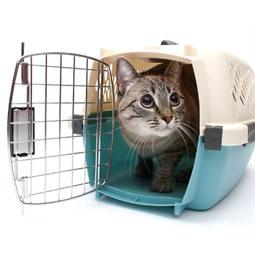
We understand that some owners have to re-home their pets due to unexpected circumstances. The information below is provided in the hopes that it will help you find a safe and happily committed new home for your cat. A cat that is not rehomed properly may find itself dumped outside or in a high kill shelter or worse (abused, bait for dog fighters, etc.)
Rehoming a cat can take a quickly as a few days (usually young purebreds or kittens) or months, so start looking as soon as possible. If you only have a week to find a new home, you will not have much luck, and you might end up settling for a home that isn’t right for your pet out of desperation which can be a nightmare for your cat.
Make sure your cat is up to date on vaccinations and spayed/neutered. If you haven’t and are low on funds, you can try a low cost spay/neuter clinic but those usually have a waiting list. You should also microchip your pet in case the adopter loses or dumps your cat so you can be sure s/he is always safe. You will have much more luck finding a home for it if you can provide veterinary records showing the cat’s health status. A responsible and informed adopter will want to know all of this information. A red flag is an adopter who doesn’t ask about the medical condition or records.
First look to your circle of trusted friends, family members, and coworkers. Are any of them willing to give your cat a loving and responsible home? Please do not contact a rescue until you’ve exhausted every other option. Rescues are already overcrowded, and for every cat surrendered to a rescue, many more remain on the street or in a high kill shelter.
Some Toronto area are low kill (Toronto Humane Society, Humane Society of Durham, Georgina Animal Shelter, Vaughan Animal Services). However, others are not (OSPCA, Toronto Animals Services). Some high kill shelters have a very high euthanasia rate due to overcrowding regardless of the age, health or breed of the cat. Older pets and those with even minor health and behavioral problems are at an even higher risk of euthanasia. For this reason, we strongly recommend looking for a new home on your own unless recommended by a reputable rescue otherwise.
Any experienced rescue will recommend thorough screening for any potential adopter. Never agree to give your pet to someone until you have properly screened them and visited their home. Look for red flags like someone who isn’t interested when you tell them about your cat or doesn’t ask any questions about him/her. We will includes some suggestions later in this article.
If your cat has health or behavioral problems, such as aggression or litter box issues or requires a special diet, be up front about it with potential adopters. The last thing you want is to adopt your cat to an unsuspecting person who later rehomes the cat again (or surrenders it to a shelter) due to an unanticipated problem. If your cat doesn’t like dogs or female cats or kids, make sure the adopter knows even if their home doesn’t have those elements in case they move in the future or place the cat somewhere when they go on vacation.
While any people turn to online classifieds like Kijiji or Craigslist, we don’t recommend them as the first choice.. You can post a free classified on Petfinder.com. However, use these websites with CAUTION. Some tips:
Is your cat a legit purebred or mixed with a purebred cat? If so, try searching for purebred rescues online. Some of them will take owner surrenders, depending on how much room they have. However, again you should exhaust every other option first. Keep in mind that purebred cats also attract a lot of people who may not have the experience or knowledge needed to deal with a purebred cat and the health problems that may come with it. For example, few people with no Bengal experience can handle the hyper activity and potential destructiveness of the breed. Many purebreds have specific health concerns that only educated or experienced purebred owners realize. Be careful not to rehome your purebred to someone who just wants a showpiece.
You MUST screen all potential adopters. Please do not forgo this step. NEVER agree to give your cat to someone until you have properly screened them–after all, this person will need to care for your cat for the next 15-20 years At the very least, the process should include:
You can also include:

Every applicant who mentions a current or recent (past 5 years) pet should provide a veterinary reference. Standard veterinary care includes spay/neuter, vaccinations, and an annual exam. Some folks may not vaccinate their older cats due to the risk of cancer — this is fine, as long as they are still getting an annual exam. Some important questions:
Keep in mind that some applicants don’t mention that they may have used another vet, or that they went to an emergency vet in the last weeks/days of their pet’s life. If there are holes in the vet records, give the applicant the benefit of the doubt and ask them if the animal received care somewhere else during this time. If the applicant denied treatment due to financial issues, be very wary that this may happen to your cat if adopted by applicant. As well, if an applicant’s vetting history is not stellar, you can ask him/her if there is anything they would do different. Sometimes people learn about cat health requirements the hard way and regret it.
Personal references can be used with applicants who don’t have vet records, or in addition to vet records if you wish. This is used to verify pet ownership history and get a feel for the applicant and how they would care for an animal. Here’s an example of some questions to ask:
If the applicant is a renter, be sure s/he is allowed to have pets and that it is clearly stated in the lease. After all, you don’t want to adopt a cat to an applicant, only to have it returned a month later when the landlord finds out! Call the landlord and see if there is any fee or condition associated with having a pet, and to notify the landlord that his/her tenant is planning to adopt from you.
The references checked out and you are ready for the applicant to meet you and your cat in your home–great! Take the chance to ask more questions and observe. This is also a chance for the adopter to ask questions about your cat’s health, behaviour, and likes/dislikes. Above all else, go with your instincts. If something doesn’t feel right, do not adopt your cat to that applicant. You will regret it later and may find that your instincts were right.
If all the references check out and the meet and greet with you and the foster cat goes well, you want to do a home visit. You can conduct the home visit when you go to drop off your cat, but always be prepared to turn around and bring the cat back if you don’t like what you see. Pay attention to the safety of the home for a cat: are there broken windows, missing window screens, doors that don’t latch, holes in walls, plants poisonous to cats, or unsafe electrical wires? If your cat is a kitten, have they “kitten-proofed” the home? Where the cat will be staying–does it get the run of the house? Where will its bed, food, water, and litterbox be?
The adoption contract should outline the conditions of adoption and what will happen if those conditions are not met. It should also state what will happen to the cat if the new arrangement doesn’t work out. You can download a sample Adoption Contract from some rescue sites and use it as-is or edit to suit your needs. We also highly recommend charging a fee, however small. This will subsidize the cost of the veterinary care, but it will also discourage adopters who may not value your kitty. If someone is not willing to pay $25-100 to adopt the cat, what will happen with a much larger vet bill? Speaking of vet bills, be sure you give the cat’s vet records (or the vet’s name and phone number) to the adopter.
Remember to provide any supplies when you drop off your adopted cat. You should provide a blanket that has familiar smells from your home to ease the transition and any toys, scratchers, litter boxes and/or bowls for the same reason. Always transport your kitty in a carrier. Do not carry him/her as s/he may get spooked and get away or get hurt if the car stops short. Also provide a bit of food and litter so the new adopter can transition your cat easily so the cat won’t have stomach issues or litter box mistakes due to a drastic change. If the adopter has another cat, make sure that they do a slow introduction and not merge the cats together right away. The integration should take several days or else it could be a disaster.
Make sure you are able to follow up on how your cat is doing. You should leave your contact information for the adopter in case s/he has any questions or concerns. If you cut them off immediately, then you risk your cat being dumped or rehomed.
While this sounds like a lot of steps, please keep in mind that it can be a dangerous world out there for an animal. Your diligence will guarantee that your cat will be safe and happy and have the lifelong stability that s/he deserves.